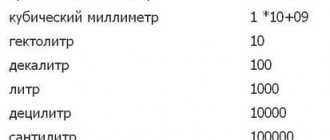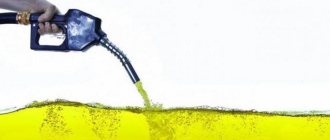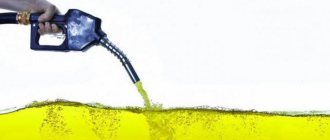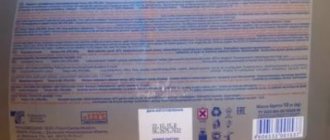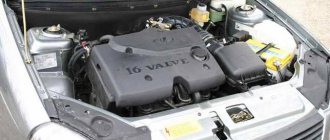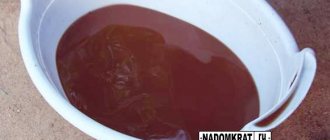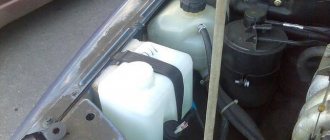How many liters of methane are in a cube?
As people call it the “long-suffering” cubic meter – m3. Abbreviations such as cube and cubic meter are especially often used, universally accepted and understood by everyone. Our “people” do not change liters, their mentality does not allow it. The question of how many liters are in 1 cubic meter or one cube of methane may be of purely educational interest. Previously, this worried mainly schoolchildren and junior students solving problems in physics. However, today, people who are far from the school curriculum are beginning to remember long-forgotten information. Perhaps they want to check the accuracy of the calculations made on their own when converting liters to cubes, cubic meters or cubic meters - m3. Many drivers are accustomed to correlating fuel consumption and the mileage that a car can travel after refueling, based on the number of liters of gas filled into the cylinder. At gas stations, methane is counted in cubes. The task is quite simple, but often “complicated” by incorrect formulations of the question. Therefore, let's take a closer look.
Along the way, I consider it necessary to clarify the term: liquefied gas, which is often associated with the question: how many liters of methane are in a cube. Liquefied gas itself is not a separate “type” of methane, but a unique state of aggregation into which any existing gas can be “transformed.” Technically, to obtain a liquefied state, a gas or air (which is also a gas) is cooled to a temperature at which it becomes a liquid. This technology is widespread and has practical meaning not for methane, but for propane and butane. The cooling temperature with gas liquefaction technology in this case is minus 160 degrees Celsius. That is why propane, butane and proportional mixtures of these gases are most often counted in liters. Methane is usually not liquefied, but compressed. This is another gas storage technology in which it does not turn into a liquid state, remaining in a “normal” state of aggregation. Therefore, methane at gas stations is counted in cubic meters.
Cubic meters and liters are units of volume that do not themselves take into account any additional physical characteristics of methane or its chemical composition. Pure mathematics. Therefore, let's take a look at the reference book of weights and measures. To do this, it is most convenient to use the ratio from the table of volumes, which clearly indicates that one cubic meter of any substance contains 1000 liters of the same substance. At the same time, it does not matter at all what kind of gas we are measuring. Hot, cold, warm, discharged, compressed, liquefied, frozen or whatever. Moreover, volumetric measurement is also possible not only for liquids and gases, but for bulk materials and theoretically for solids. For example, if we measure sand rather than gas in liters (let’s say we need this for some reason), then one cube of sand will contain the same 1000 liters.
You can often find very strange explanations for the question of how many liters of methane are in a cube, boiling down to the fact that temperature, pressure, density or other physical parameters supposedly influence this ratio. This is actually a myth. The number of liters of “hot” methane in one cubic meter m3 and the number of liters of liquefied methane will be the same - 1000 liters. As, indeed, the number of liters of compressed methane or frozen to the state of ice: in one cube, also 1000 liters.
The chemical composition of methane, its purity or the presence of any impurities, do not in any way affect the number of liters in a cube of methane.
Another thing is that gas can be in the state of both a liquid and a solid (ice). Significantly changing its volume depending on temperature, especially during the transition from one state of aggregation to another. This is due to a change in its density, and therefore weight. That is, a liter or 1 cubic meter of the same methane can have different masses. But, that's a completely different story. It is completely incorrect, for example: to take liters of methane in ice state and compare it with the amount of heated methane in 1 cubic meter. This is absurd when the question is posed this way. At constant temperature and pressure, the amount of methane measured in liters will be the same in 1 cubic meter, those same 1000 liters. The presence of impurities in the gas refers to its chemical composition, and can actually affect the mass of one cubic meter of methane or one liter. But the ratio of how many liters are in a cube will remain unchanged. For clarity, you can imagine exactly the same “story” with the same sand. Black sand, white, fine, coarse, quartz or with an admixture of clay - it doesn’t matter at all. In any case, exactly 1000 liters of substance will “fit” in one cubic meter. No more and no less, subject to the immutability and constant of its physical characteristics.
| Home News Metal structures Gallery Contacts |
| © PE Kolesnik 2010-2011 |
Our address: Dnepropetrovsk, st. Karl Liebknechta 57 Phone in Ukraine: (063) 796-79-32 or (063) 796-19-32
How long can you drive on methane?
Table of advantages and disadvantages of propane and methane
| Factor | Propane | Methane |
| Consumption relative to gasoline (per 10 liters) | 11-11.5 liters | 8-8.5 cubes |
| Average tank weight | 20-30 kg | 60-125 kg |
| Fuel reserve for average set (kilometers) | 600-1000 km | 250-350 km |
| Explosive concentration in air | 2,1% | 4,4% |
Physical meaning of translation
In a physical sense, everything is quite simple. The translation is carried out in the same way for any gases, liquids or bulk materials as follows:
- 1 cubic meter contains 1000 liters,
- 1 liter equals 0.001 cubic meters
- the table shows the quantity contained in 1 cube (1 cube = 1000 cubic decimeters, etc.).
For example, 15 cubic meters of natural gas used by the meter equals 15,000 liters. When converting these values, the temperature of the fuel, the amount of impurities and other factors do not matter.
How many liters of gas are in a 50 liter cylinder?
In a household gas cylinder with a volume of 50 liters, according to current regulations, there should be no more than 85% of liquefied gas from the volume of the cylinder. 50 * 0.85 = 42.5 liters of gas. At the gas station you can be told the amount of gas to fill in both liters and kilograms.
Interesting materials:
How to add ink to an HP printer? How to fill a full tank of gasoline? How to Tin a ceramic soldering iron tip? How to cover up an inscription in Photoshop? How to slow down music in Sony Vegas Pro 13? How to replace Internet Explorer with Microsoft Edge? How to replace How are you? How to replace rights after expiration? How to replace expired rights in 2022? How to replace tomato paste with tomatoes?
How many kilograms are there in a liter of methane?
Mass is a characteristic of a body, which is a measure of gravitational interaction with other bodies.
Volume is a quantitative characteristic of the space occupied by a body, structure or substance.
Density is a physical quantity defined as the ratio of body mass to body volume.
The relationship between liters and kilograms of methane is determined by a simple mathematical formula:
V – volume; m – mass; p – density.
In the calculation, the density of methane = 0.7168 kg/m3 was taken.
The density of methane can vary depending on temperature and pressure. You can find the exact density of methane in reference books.
See also the universal program for converting liters to kg for any substance depending on its density.
If you need to convert m3 to tons, then see the program for converting tons to m3.
If you need to convert kg to m3, then see the program for converting kg to m3.
Question: How many kg are there in a liter of methane?
Answer: 1 kg of methane is equal to 1395.1 liters.
Question: How many liters are there in a kilogram of methane?
Answer: 1 liter of methane is equal to 0.0007168 kilograms (kg).
You can quickly solve this simple mathematical operation using our online program. To do this, enter the initial value in the appropriate field and click the button.
This page presents the simplest program for converting kilograms of methane into liters. With this online calculator you can convert liters of methane to kg and back in one click.
The number of liters contained in a cubic meter of gas is not as simple a question as it might seem at first glance, given the peculiarities of using gas fuel. Let's consider ways to convert the volume of gases used as fuel, taking into account their characteristics.
Operating and Maintenance Costs
Well-regulated gas equipment requires virtually no maintenance, since neither liquefied nor main gas forms carbon deposits and soot. Preventive maintenance and control inspections are carried out regularly regardless of the type of fuel, and the costs are approximately the same.
Operating costs when using liquefied gas may include electricity costs if the system uses electrically heated evaporators. Evaporators are installed in powerful industrial systems to increase the rate of formation of the vapor phase, as well as with ground-based gas holders, since the natural evaporation of the butane component stops at subzero temperatures.
But electric evaporators are usually used in systems with relatively little gas consumption, and they do not consume as much energy. High-performance systems use liquid-heated evaporators, the heat for which is produced by burning the same liquefied gas.
So, the operating and maintenance costs for systems running on mainline and liquefied gas are almost the same.
How to calculate gas payments in a private home?
To calculate the fee, the difference between the current and previous meter readings is taken. This value is the volume of gas consumed per
month.
Monthly fee = volume of gas
X per tariff.
Interesting materials:
How to fix a washing machine door? How to clean LG washing machine drum from scale? How to clean the drum of a Samsung washing machine? How to clean the filter of a Samsung Eco Bubble washing machine? How to clean the filter in an Ariston washing machine? How to clean the filter in an Electrolux top-loading washing machine? How to clean the filter in a Samsung Diamond washing machine? How to clean the dishwasher inlet filter? How to clean the impeller in a washing machine? How to clean the tray of an Indesit washing machine?
When does a gas turn into a liquid?
To evaporate any liquid, heat must be supplied to it (it is called the heat of evaporation). The evaporation of liquid nitrogen, liquid hydrogen or liquid helium occurs at low temperatures. By evaporating liquid helium in a vacuum, it is possible to obtain a temperature only 0.7 K above absolute zero. ...
Interesting materials:
What is the most delicious beer in Belarus? What generation of Intel processors? What field exists around moving electric charges? Which hemisphere of the brain is more developed in left-handed people? What kind of government is there in Canada? What nickname did Alexander Sergeevich have at the Tsarskoye Selo Lyceum near St. Petersburg? What is the distance between Anapa and Sochi? What is the distance from Odessa to Turkey across the sea? What decision can the appellate court make? What's the safest place?
Use of liquefied gas
It’s a little more complicated with liquefied gas. It is widely used:
- in modern industrial production;
- in thermal and electric power engineering;
- as a reserve stock during the period of the most intensive consumption by the population;
- as a replacement for traditional gasoline or diesel fuel for road transport;
- for domestic purposes.
In the household, it is advantageous to use liquefied gas in cylinders for the operation of gas-consuming household appliances, provided there is no centralized supply line.
Various mixtures of propane and butane are used for liquefaction. The use of methane is not economically profitable, since at room temperature the pressure in the system increases so much that to ensure safety it is necessary to create containers with large wall thicknesses and use materials of increased strength.
The change in gas volume during the transition from the liquid phase to the gaseous phase is determined by the following factors:
- chemical composition;
- pressure;
- temperature;
- density and specific gravity.
To calculate the number of liters of liquefied gas per cubic meters of fuel that have turned into a gaseous state, it is necessary to use the specified characteristics. But since it is difficult to reliably establish the exact composition of the mixture in the cylinder, it is necessary to be guided by an approximate ratio, according to which at a standard temperature of 20 degrees, 1 liter of liquefied gas will produce 200 - ordinary gas. Therefore the formula applies:
Okub = Ol/5
- Cube – volume in cubic meters;
- Ol – volume in liters.
When making calculations, it is necessary to additionally take into account that, for safety reasons, gas cylinders are filled to no more than 85 percent of the total volume.
Calculation example
It is necessary to determine how many cubic meters of gas one cylinder with a 50-liter propane-butane mixture contains if you pass its contents through a gas meter:
- the mass of the gas mixture pumped into it is about 21 kilograms;
- volume in m³ is equal to 50/5 = 10;
- after adjusting for the filling of the cylinder, we get 10 × 0.85 = 8.5 m³.
This indicator may vary depending on the ambient temperature, since when it decreases, the pressure inside the container decreases, with a corresponding decrease in the volume of fuel.
But the use of liters of gas in cubic meters is only relevant as an approximate calculation. When purchasing this type of fuel, kilograms of the gas mixture and the pressure inside the container are important, and when using individual metering devices, a standard unit of measurement is used - cubic meters, the conversion procedure of which does not depend on the composition of the gas and is determined by a simple arithmetic calculation in the ratio of 1 to 1000.
How many liters of methane are in a cube?
As people call it the “long-suffering” cubic meter – m3. Abbreviations such as cube and cubic meter are especially often used, universally accepted and understood by everyone. Our “people” do not change liters, their mentality does not allow it. The question of how many liters are in 1 cubic meter or one cube of methane may be of purely educational interest. Previously, this worried mainly schoolchildren and junior students solving problems in physics. However, today, people who are far from the school curriculum are beginning to remember long-forgotten information. Perhaps they want to check the accuracy of the calculations made on their own when converting liters to cubes, cubic meters or cubic meters - m3. Many drivers are accustomed to correlating fuel consumption and the mileage that a car can travel after refueling, based on the number of liters of gas filled into the cylinder. At gas stations, methane is counted in cubes. The task is quite simple, but often “complicated” by incorrect formulations of the question. Therefore, let's take a closer look.
Examples of converting liters to cubes
And now, armed with all the necessary knowledge, we can proceed directly to the calculations.
| Problem #1: How many liters are in 0.5 cubes? Solution: Using the above formula we get: 0.5 * 1000 = 500 liters. Answer: 0.5 cubes contain 500 liters. | Problem #6: How many liters are in 300 cubic meters? Solution: 300 * 1000 = 300,000 liters Answer: There are 300 thousand liters in 300 cubic meters. |
| Problem #2: How many liters are there in 1 cubic meter? (the simplest) Solution: 1 * 1,000 = 1,000 liters. Answer: 1 cube contains 1,000 liters. | Problem #7: 5 cubes - how many liters? Solution: 5 * 1000 = 5,000 liters Answer: 5 cubic meters is 5 thousand liters. |
| Problem #3: 2 cubes – how many liters? Solution: 2 * 1,000 = 2,000 liters. Answer: 2 cubes contain 2,000 liters. | Problem #8: 6 cubic meters is how many liters? Solution: 6 * 1000 = 6,000 liters. Answer: 6 cubes contain 6 thousand liters. |
| Problem #4: How many liters are in 10 cubes? Solution: 10 * 1000 = 10,000 liters Answer: 10 cubes contain 10 thousand liters. | Problem #9: How many liters are 4 cubes? Solution: 4 * 1000 = 4,000 liters Answer: 4 cubes contain 4 thousand liters. |
| Problem #5: 20 cubic meters is how many liters? Solution: 20 * 1000 = 20,000 liters Answer: 20 cubes contain 20 thousand liters. | Problem #10: How many liters are 500 cubic meters? Solution: 500 * 1000 = 500,000 liters Answer: There are 500 thousand liters in 500 cubic meters. |
How many liters are in 1 cubic liter?
Let's start with a lyrical digression, namely from a school physics course. It is known that the generally accepted unit of volume measurement is the cubic meter. 1 cubic meter is the volume of a cube whose side is exactly one meter.
1 cubic meter
This unit is not always convenient and it is for this reason that others are very often used - liters - also known as cubic decimeters and cubic centimeters.
As practice has shown, the most convenient unit of volume measurement is the liter, which is the volume of a cube whose length is 1 dm or 10 cm. Thus, we find that all the questions of how to convert a dm cube into cubes are equivalent to the question: how to convert liters into cubes, because 1 dm. cube = 1 liter.
1 liter
